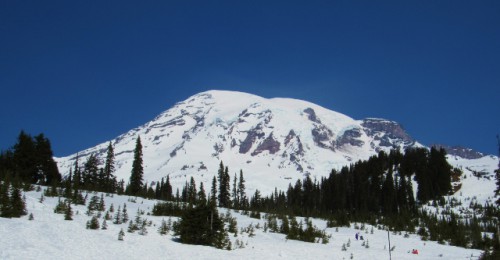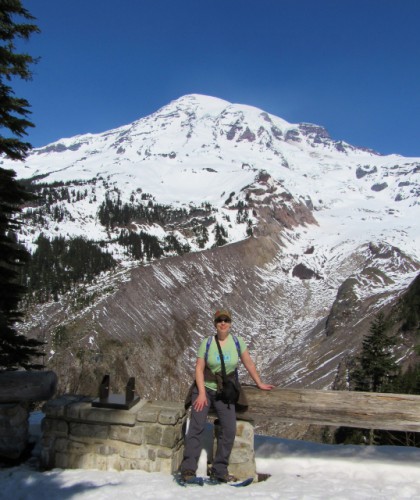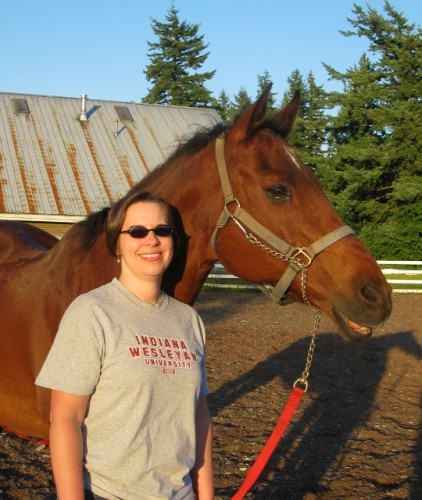Mount Rainier wasn’t the first National Park, but it was the first park created from an already established National Forest (then called National Forest Reserves). At the time, the Forest Reserves were intended to protect land under Gifford Pinchot’s philosophy of “conservation through use,” which conflicted with John Muir’s preservationist mindset. Lucky for us Washingtonians, we had Muir on our side. He had visited Mount Rainier in 1888 and felt re-invigorated by his trip; he rededicated himself to the cause of preserving nature through a series of National Parks.
With support from the Sierra Club, the National Geographic Society, the Northern Pacific Railroad, and business leaders in Seattle and Tacoma, WA, the Pacific Forest Reserve (designated in 1893 and enlarged and renamed Mount Rainier Forest Reserve in 1897) was converted by Congress and President William McKinley to Mount Rainier National Park on March 2, 1899. It was this nation’s fifth National Park.

Mount Rainier from the Longmire Historic District
Today the park encompasses 236,381 acres (369.35 square miles), and its main feature is the 14,410 foot stratovolcano Mount Rainier. The mountain is the highest in the Cascade Range, and has valleys, waterfalls, sub-alpine meadows, old-growth forest and over 25 glaciers; Rainier has the highest number of glaciers in one place in the lower 48 states.
Several Native American tribes have used the park for hunting and gathering for thousands of years, but there is no archaeological evidence of permanent habitation within the boundaries of the park. Artifacts found within the park include projectile points and hunting artifacts (the projectile point dates to 4,000-5,800 BP) and a rock shelter.
In its early days as a National Park, Mount Rainier was popular for its mineral springs in the Longmire District of the park. James Longmire was largely responsible for the first development in this section and the entire park is designated as a National Historic Landmark District today. Later on, hiking, skiing and snowshoeing became more popular with tourists, especially after the opening of the road to Paradise and the Paradise Lodge in 1916.
The Wonderland Trail draws many adventurers – it is a 93 mile hiking trail that circles the park. You can hike the whole thing, camping along the way, or choose a section for a day hike. Mount Rainier is also popular with mountaineers, with over 10,000 summit attempts each year – about 50% are successful. Unfortunately, since Mount Rainier became a National Park in 1899, 116 people have died climbing the mountain. A total of 411 have died within the park boundaries; this total includes those who died climbing and those who were engaged in other recreational pursuits.
Sadly, some of the people who are drawn to the wilderness don’t come for benevolent purposes. On January 1, 2012, Benjamin Colton Barnes murdered Park Ranger Margaret Anderson while trying to flee into the wilderness. Barnes had shot 4 people at a New Year’s Eve party in Renton, WA – two critically – before arriving at the park heavily armed. After a manhunt involving 200 law enforcement officers and a swift water rescue team, Barnes was found dead of drowning (hypothermia contributed) in Paradise Creek.
I mention Ranger Anderson’s murder because it was so significant for us in the Pacific Northwest. It is the only time I know of when an entire National Park was closed and evacuated during a manhunt. It was huge news and a true tragedy when considering what our National Parks stand for. However, 1,038,229 people visited the park in 2011, so despite the dangers of mountain climbing or accidents, the mountain is still very safe for visitors.

The entrance to Mount Rainier at Longmire – sparkling in the light of a gorgeous spring morning!
Jon and I spent a spectacular sunny and warm weekend there in April, staying at the National Park Inn in the Longmire District. Despite growing up so close, neither of us had visited Mount Rainier before! I will tell you about our visit in my upcoming posts!































